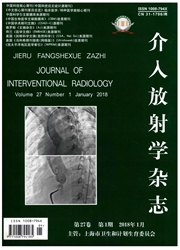

 中文摘要:
中文摘要:
目的 评价超顺应经内镜钳道结肠支架治疗肝脾曲结肠恶性梗阻的可行性和治疗效果。方法 2013年9月至2014年7月超顺应经内镜钳道结肠支架治疗肝脾曲结肠恶性梗阻患者7例。内镜及透视引导下行支架置入,评价其技术和近期临床成功率、并发症和临床移位率。结果 恶性结肠梗阻部位肝曲1例,脾曲6例,平均曲度为125.7°±20.7°,技术均获成功,无支架相关性并发症。支架姑息性治疗3例,手术过渡治疗4例,7例临床梗阻均缓解,患者腹围由术前的(87±3) cm降至术后7 d的(70±6) cm。4例行1期手术,支架置入时间为8~10 d,平均(9.3±1.0) d,无吻合口瘘和术后再狭窄。生存期为4~14个月,平均(8.7±3.6)个月。结论 超顺应经内镜钳道结肠支架治疗肝脾曲结肠恶性梗阻安全有效,可作为肝脾曲恶性梗阻的首选治疗方法。
 英文摘要:
英文摘要:
Objective To evaluate the feasibility and curative effect of super-flexible through-thescope (TTS) self-expandable metallic stent (SEMS) insertion for the treatment of malignant colonic obstruction at hepatic flexure or splenic flexure. Methods From September 2013 to July 2014 a total of seven patients with malignant colon obstruction located at hepatic flexure or splenic flexure were treated with super-flexible TIS-SEMS insertion. Under endoscopic and fluoroscopic guidance, the implantation of stent was performed in all patients. The technical success rate, the short-term clinical success rate, the occurrence of complications and the clinical remission rate were evaluated. Results The obstruction was located at the hepatic flexure colon in one patient and at the splenic flexure in 6 patients; the mean curvature degree was 125.7°+20.7°. The technical success rate was 100%. No stent-related complications occurred. Stent insertion used as a palliative treatment was employed in 3 patients, and stent implantation used as a transition means to surgery was adopted in 4 patients. The clinical remission rate was 100%. The mean abdominal circumference was decreased from preoperative (87±3) cm to postoperative (70±6) cm. One-stage surgery was carried out in 4 patients; the indwelling time of the stent was 8-10 days, with a mean of (9.3±1.0) days. No anastomotic fistula or postoperative re-stenosis occurred. The survival time was 4-14 months, with a mean of (8.7±3.6) months. Conclusion For the treatment of malignant colonic obstruction located at hepatic flexure or splenic flexure, super-flexible TrS-SEMS insertion is effective and safe. This technique can be used as the preferred method in treating malignant colonic obstruction at hepatic or splenic flexure.
 同期刊论文项目
同期刊论文项目
 同项目期刊论文
同项目期刊论文
 期刊信息
期刊信息
